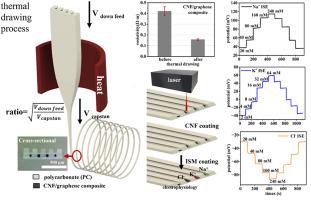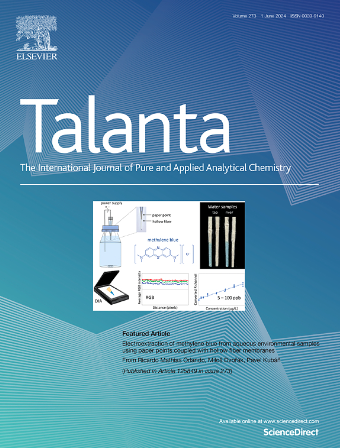推进多重离子监测技术:开发基于热拉伸聚合物纤维的集成离子探针。
IF 6.1
1区 化学
Q1 CHEMISTRY, ANALYTICAL
引用次数: 0
摘要
由于离子稳态在生物系统中的关键功能,对体内离子稳态的监测具有至关重要的意义。然而,目前制造离子选择电极的领先技术在多功能性、小型化和灵活性方面往往达不到体内应用的要求。为了解决这一差距,我们引入了一种集成的多路离子监测探针,该探针由热拉伸的多电极聚合物纤维制成,旨在加强体内离子稳态研究。该探针采用碳纳米纤维(CNF)/石墨烯复合材料作为传感材料,利用热拉伸工艺、激光加工和材料功能化来制造多路离子探针。我们的设计结合了微米级光纤上的电极,用于感应Na+, K+和Cl-离子,以及用于电生理记录的电极,在蒸馏水和人工脑脊液溶液(aCSF)中实现了出色的灵敏度,稳定性,选择性和可逆性。这些结果证明了该探针在未来体内应用的潜力。本文章由计算机程序翻译,如有差异,请以英文原文为准。

Advancing multiplexed ion monitoring techniques: The development of integrated thermally drawn polymer fiber-based ion probes
The monitoring of ion homeostasis in vivo is of paramount importance due to its critical functions in biological systems. However, current leading technologies for creating ion-selective electrodes often fall short of the requirements for in vivo applications in terms of multiplexity, miniaturization, and flexibility. To address this gap, we introduce an integrated multiplexed ion monitoring probe created from thermally drawn multi-electrode polymer fiber, aimed at enhancing in vivo ion homeostasis studies. This probe employs a carbon nanofiber (CNF)/graphene composite as the sensing material, utilizing a thermal drawing process, laser machining, and material functionalization to fabricate multiplexed ion probes. Our design incorporates electrodes on micron-scale fibers for sensing Na+, K+ and Cl− ions, alongside an electrode for electrophysiology recording, achieving excellent sensitivity, stability, selectivity, and reversibility in distilled water and artificial cerebrospinal fluid solutions (aCSF). These results demonstrate the potential of the probe for future in vivo applications.
求助全文
通过发布文献求助,成功后即可免费获取论文全文。
去求助
来源期刊

Talanta
化学-分析化学
CiteScore
12.30
自引率
4.90%
发文量
861
审稿时长
29 days
期刊介绍:
Talanta provides a forum for the publication of original research papers, short communications, and critical reviews in all branches of pure and applied analytical chemistry. Papers are evaluated based on established guidelines, including the fundamental nature of the study, scientific novelty, substantial improvement or advantage over existing technology or methods, and demonstrated analytical applicability. Original research papers on fundamental studies, and on novel sensor and instrumentation developments, are encouraged. Novel or improved applications in areas such as clinical and biological chemistry, environmental analysis, geochemistry, materials science and engineering, and analytical platforms for omics development are welcome.
Analytical performance of methods should be determined, including interference and matrix effects, and methods should be validated by comparison with a standard method, or analysis of a certified reference material. Simple spiking recoveries may not be sufficient. The developed method should especially comprise information on selectivity, sensitivity, detection limits, accuracy, and reliability. However, applying official validation or robustness studies to a routine method or technique does not necessarily constitute novelty. Proper statistical treatment of the data should be provided. Relevant literature should be cited, including related publications by the authors, and authors should discuss how their proposed methodology compares with previously reported methods.
 求助内容:
求助内容: 应助结果提醒方式:
应助结果提醒方式:


